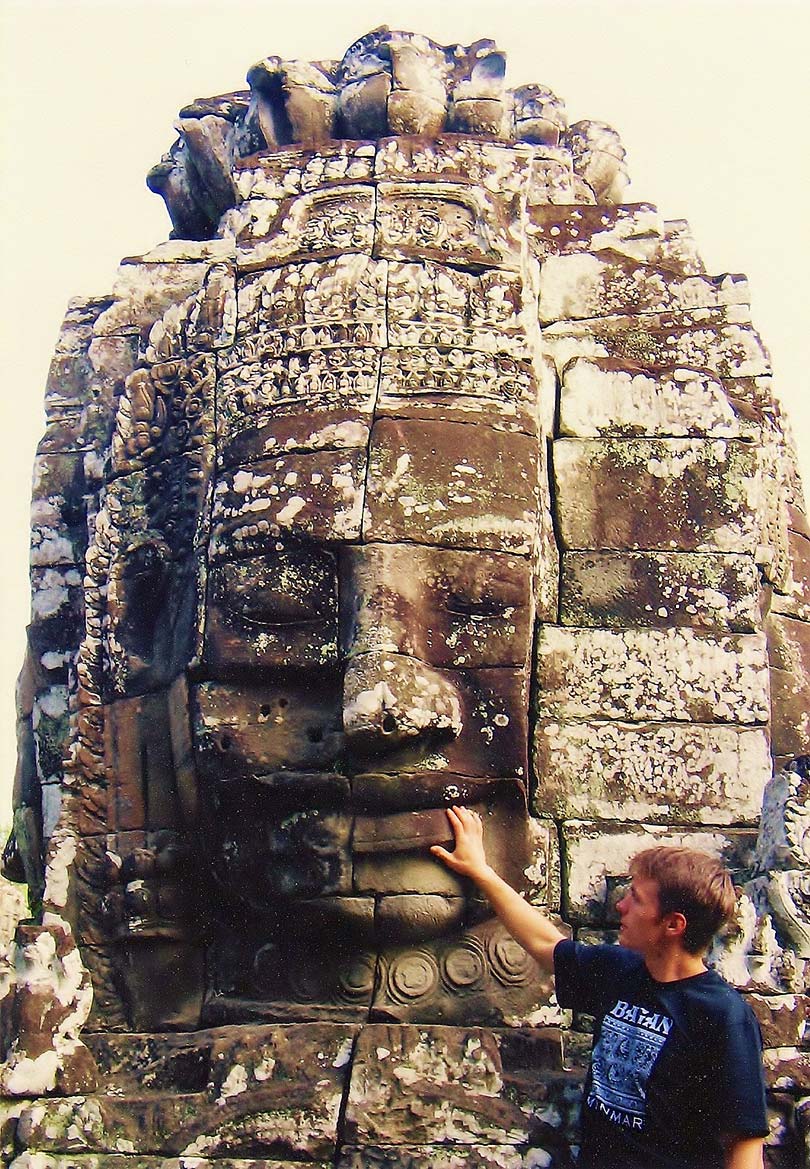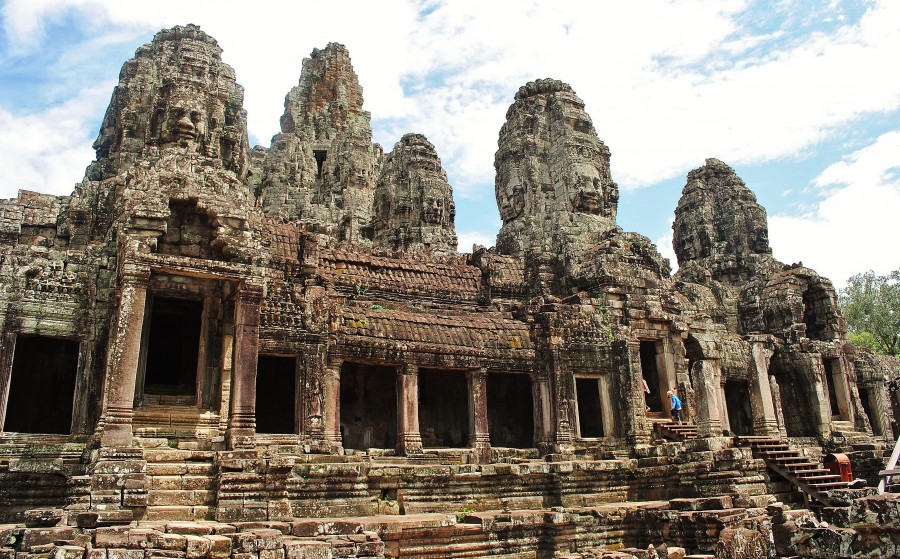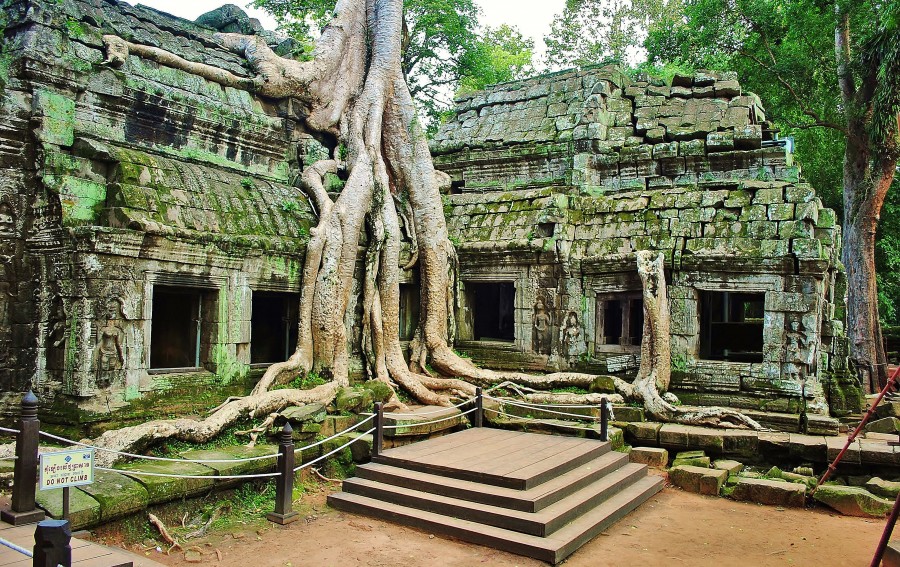Angkor Wat temples in Cambodia
The temples of Angkor Wat in Cambodia
The temples of Angkor Wat in Cambodia are the national pride of this country. Until the mid-nineteenth century this lost city was considered only a myth, and an unattainable relic of the past, lying deep in the jungle. Even more so, when the temples of Angkor were finally discovered, the surprise was endless. The temples of Angkor Wat were built by the Khmer Empire as Hindu temples, dedicated to the Hindu god Vishnu, but from the twelfth century they were converted into Buddhist temples.
The development of Cambodia in 8 years and the town of Siem Reap
The temples of Angkor are the national pride and the basis of the national identity of Cambodia, whose size is appreciated throughout the world. Because of this, a number of maintenance works take place in their area, which improve their condition. For example, in 2004, when I climbed the main temple of Angkor Wat, I thought I would fall and break my neck. It was the same with all other temples built in the form of pyramids. In 2012, there were wooden stairs in Angkor, which significantly improved safety. In the Ta Prohm temple, one gate was modernized, as seen in the pictures taken a few years ago and now. The difference is huge!
Siem Reap is the starting point for Angkor Wat, and that’s why it is a typical tourist town into which Cambodians have invested a lot of money. Last time I was in Cambodia in 2004, and then Cambodia did not even have roads. In 2004 the basic infrastructure of Cambodia was just developing. I drove a car on a beaten road avoiding huge pits, and people lived in the jungle by the road in wooden huts. Electricity was not everywhere, and there were no cash machines. Travelling in Cambodia in 2004, to me was like travellling in time. I saw bamboo scaffolding, buffalo plowing rice fields, and the very simple life of the Cambodian nation. However to me, a Polishman, it was interesting and beautiful.

Angkor Wat.
By 2012 Cambodia has developed a lot. As soon as I crossed the border from Thailand, someone immediately shouted with joy, that now Cambodia is a modern country because they already have roads. It was already late when I arrived in Siem Reap, but I soon realized that within 8 years Cambodians built a new city. In 2004 Siem Reap looked like a flat, compacted land with tin barracks, where old mopeds were repaired. However, in 2012 there were already a lot of shops, cheap and more expensive hotels nicely located by the river, restaurants, massage salons, and gelleries with Cambodian art. I think that Siem Reap offers a lot of art; mainly paintings and sculptures referring to the temples of Angkor Wat. I had a room made entirely of bamboo, with a mattress and a mosquito net, for just a few dollars. In the evening I always walked along the river or sat in a bar with other foreigners, where we talked about travels, and of course Angor Wat temples. Siem Reap is a very nice tourist town, where I spent a very nice time.
Unfortunately, I also quickly noticed that the same is in the neighbouring Thailand, Siem Reap also had its dark side. Well, it is a brothel, waiting for a tourist wherever he goes. The girls were waiting in bars and standing in the streets, but from what I noticed tourists were afraid of diseases. Cambodia is a high risk HIV country, that’s why I rather recommend to concentrate on art and culture.

Buddhist monks in front of Angkor Wat.
A brief history of Angkor Wat
The temples of Angkor are the remains of a lost city dating from the X-XII century, and are the relic of the ancient capital of the Khmer Empire. It is a complex of buildings, temples, sculptures, forested areas and water reservoirs, that are unmatched. Until the mid-nineteenth century this lost city was unknown to the world. For centuries it was regarded only as a myth, which seemed to be an unattainable relic of the past, lying deep in the jungle. For that reason, when the Angkor temples were finally discovered, the surprise was endless. To this day, Angkor Wat is one of the largest religious complexes in the world, covering an area of 162.6 hectares. The temples of Angkor Wat were built for the Khmer Empire as Hindu temples, dedicated to the Hindu god Vishnu, but from the twelfth century they were converted into Buddhist temples.
Cambodians had one of the Wonders of the World under their noses, but they didn’t realize what treasure they had. From the point of view of culture and the world art, I am pleased that Cambodia was part of the French Indochina, because for the modern world the complex of the ancient Angkor Wat temples were discovered by the French traveller Henri Mauhot in 1860. Then in 1863 he published a travel report from his expedition on this subject, and he was recognized as the discoverer of the legendary “lost city of Angkor”. I think that it is a very important information, because in the current times, when the Cultural Marxists destroy White people and blame them for all the sorrows, it turns out that European colonialists did a lot of good things. In addition to building the infrastructure and economy of the colonial countries, they also had an impact on the development of local culture. Angkor Wat in Cambodia and My Son in Vietnam were discovered by the French, while Petra in Jordan discovered the Swiss. The largest flower in the world rafflesia in Borneo was discovered by an Englishman, and Machu Picchu in Peru was discovered a White American.

A painting depicting Angkor Wat, in Siem Reap.
After traveling all over the world, I am convinced that the dark races have advanced technologically and culturally, because they have been fertilized by a healthy light of the white civilization.
For hundreds of years, archaeologists kept cleaning the temples of Angkor from the jungle, giving it today’s image; and still this unique place is being improved. With the passing centuries, the temples of Angkor became part of the jungle, and although many temples were cleared of trees and massive roots, some were not touched, as it would certainly destroy the construction of some buildings. The best example here is the temple of Angkor Thom, where I saw how a building made of stones, and tree roots have become one inseparable element.
When the Khmer Rouge came to power, they tried to destroy the lost city of Angkor with very primitive explosives, but fortunately they didn’t succeed. In the tragic time for Cambodia, Pol Pot also ordered the deportation of all scientists from Cambodia, and the restoration works were stopped. Today, despite better and worse times, the whole area of Angkor Wat is a phenomenon of religious and cultural architecture. I think that everyone who travels through Southeast Asia should definitely see them.
In 1992 Angkor Wat was honoured by the UNESCO, to become the world cultural heritage site. I don’t think that great honour was a surprise, as it covered the famous temples of Angkor Wat, Angkor Thom and Bayon. In addition, UNESCO honored Angkor as “the best UNESCO World Heritage Site”, and continues to commission conservation works to scientists.

Tourists in front of the main temple of Angkor Wat.
Comparison of Angkor – 2004 and 2012
The temples of Angkor are the national pride and the basis of the national identity of Cambodia, whose size is appreciated throughout the world. Because of this, a number of maintenance works take place in the area, which improve their condition. For example in 2004, when I climbed the main temple of Angkor Wat, I thought I would fall and break my neck. The same with all the other temples built in the form of pyramids. However, in 2012 there were already wooden stairs in Angkor, which significantly improved safety. In the Ta Prohm temple one gate was modernized, as it could be seen in the pictures taken a few years ago, and now. The difference is huge!
In 2008 archaeologists also put together the Baphuon temple, what let me see something new. On the elephant terrace inside the city of Angkor Thom, a new lion was built, and in front of the gate to Angkor Thom, statues depicting soldiers holding a seven-headed serpent are more complete. In 2004 many of them didn’t have heads, but in 2012, they were added. As for the last two things, this is obviously good, but on the other hand it takes away from the realism of Angkor, because the newly built sculptures are of different colours than the old ones. The gate to the city of Angkor Thom itself is supported with iron constructions.
I also want to add that the area of Angkor Wat temples is not the only one in Cambodia, which is worth seeing. In addition to Angkor, there are many other temples with numerous bas-reliefs, which are in close proximity. These are for example: Banteay Srei i Kbal Spean, which can be seen on one-way trips from Siem Reap. Maintenance works are also going on there.

The Angkor Thom gate.
I want to remind that the empire of brave Khmers did not only cover the territory of the present Cambodia. In the neighboring Laos I recommend to see the Champasak temples, which were built in the same style.
Introduction to my travels around Angkor Wat and practical information
This time, the purpose of my trip was to visit the best temples of the great wonder of the world, and the world cultural heritage – the ruins of the ancient temples of Angkor Wat. I spent two days exploring the whole complex, and apart from that, I went on a trip to the more distant places. I took my tour very seriously and travelled according to the map. On the first day I went by rickshaw for a whole day with a group of three Americans. It came out to be very cheap, because for the whole day everyone paid only $4. The next day I went on a bike trip, and I paid only $1 for the bike,what proved to be beautiful and cheap. Entry to Angkor Wat costs $20 for 1 day, $40 for 3 days and $60 for 1 week. I spent $40, and on the first day I travelled along the green route, and followed the red route on the second day. Othe third day I went to see a waterfall and the temples located 47km from Siem Reap. It was of course interesting and educational every time.
Although I saw about one hundred or more objects, in my report about the temples of Angkor, I will limit myself only to the description of the most important temples and a general description of the whole area. My aim is to describe the most important objects, but on the other hand I want to avoid giving a lecture on the history of art. Before I go to the description of the specific temples, I would like to say that the temples of Angkor are not only about the ancient ruins. People have their lives there too. There are a few small villages there, and bars made of bamboo where tourists can eat rice with grilled chicken and coconut drinks. In Angkor temples there are also exhibitions of paintings and souvenir sellers, who push out small items for a few dollars. For example, I bought a nail clipper in the shape of the Bayon temple, and a $2 Angkor Wat t-shirt. However, the choice is huge and while visiting the temples, it would take us a long time to admire local art and interact with people.

Ta Prohm temple, with great roots entwining the building.
As I mentioned before, Siem Reap is the starting point for Angkor Wat, which is why I organized all the trips by myself.
The most important temples of the Angkor Wat complex
Angkor Wat
Typically, the first object of the visit is the national pride of Cambodia, the Angkor Wat. This temple is the largest religious building in the world and strikes not only with its size, but also with an extremely massive construction and shape. This building consists of a pyramid with five towers, the highest of which is up to 65 meters. Angkor Wat is surrounded by a moat, walls and corridors with a length of 1300 to 1500m, and the temple itself covers an area of 1km². Many walls are decorated with bas-reliefs, depicting scenes from the Hindu mythology and scenes from the victorious wars of King Suryavarman II. That ruler, who ruled over the Khmer Empire, built Angkor Wat and sacrificed it to the Hindu god Vishnu. Angkor Wat has of course its religious symbolism, and for example the entire building symbolizes the cosmos, the highest tower symbolizes the top of the mountain, and the smaller towers are the continents. When Angkor Wat was built in the tenth century, it was a huge undertaking, that is hard to imagine today. There were no trucks or excavators, so all the rocks had to be hand-hewn and brought on rafts.
Today, the whole of Cambodia lives with this temple, and it’s the biggest proof of Cambodia’s pride and national identity. In 2004 I went there before the sunrise, and left Angkor Wat after sunset, what also gave a spectacular effect. I saw then a large temple with five massive, high towers, and just before it a lake and palm trees. Then I walked to the temple area and I climbed its high but unfortunately a very short staircase. It was quite dangerous because the stairs were not secured, and it was very easy to fall. The view from the top was beautiful because it gave me a fuller picture of the whole area, and let me see the chambers, pillars, stairs and many other passages in the upper parts of the temple. At first glance, Angkor Wat requires only hour of sightseeing, but if someone wants to see more exactly all the rich details and corridors and feel the atmosphere of Angkor, I think it could take several hours.

The face of Bayon.
Angkor Thom and temples in its area
Angkor Thom
The next object was Angkor Thom, the later capital of the Khmer Empire built by King Jayavarmana VII in the 12th century. This temple has five ornate gates, and the entire city covers an area of 10km². The most impressive until this day is the southern gate, with four stone faces at its top. This ancient city was created on the plan of a perfect square, near the Tonle Sap lake, and it is surrounded by a moat. In front of Angkor Thom there is a bridge on both sides, with stone statues of soldiers pulling “naga”, a mythical serpent with seven heads. The bridge on which that building is located, and the gate to Angor Thom symbolize the eternal desire of people to reach the land of the Gods. The city of Angkor Thom was created in the style of Bayon, which is considered the “tip of the iceberg” of the Khmer architecture. I recommend everyone to stop just behind the gate, to take a good look at the stone face at the back of it, and see the roots of the trees woven into the building. Then on the top of the wall there is a view of the bridge and the river. If someone would like to enter Angkor Thom in a big way, he can do it on an elephant. In the ancient city there are many interesting temples and cheap bars with food under palm trees. There are also children selling souvenirs. It is a very pleasant part of the Angkor temples.
Bayon
The first object in Angkor Thom is the most important and the most beautiful temple after Angkor Wat. It is Bayon, which tourists can also enter through one of the four gates. The temple itself made a very strong impression on me. Especially when I approached one of the huge stone faces and when I was able to touch them. They have been here for over 800 years and have been discovered relatively recently. Bayon was also built by King Jayavarman VII in the twelfth century, and although this temple is incomparably smaller than Angkor Wat, Bayon does not give way with the quality of its art. Bayon has 54 towers decorated with 216 huge, stone faces, which are supposedly the likenesses of the king himself. Although the building is beautiful, I suspect that it was one of the ancient ways of controlling the nation. In the Bayon temple, the subjects of the king certainly felt watched, because the faces of the king looked at them from every corner of the temples. In addition, faces are neither sad nor happy. They smile gently, as if they wanted to show their irony, pride and attitude of inviolability. This is how I understand Bayon.

The Bayon temple.
Prasat Baphuon
Next to Bayon, in the vicinity of the large Buddha statue, there is the Prasat Baphuon temple, which was opened in 2008. The Khmer Rouge regime ordered to take it apart stone by stone, and hence its delay. The temple has the form of a pyramid and has many corridors and pillars. Baphuon also has several sculptures, which can be reached via a bridge, and the view from the top offers nice views. Considering the difficult puzzle that took place around 1000 a year ago, and then re-arranging it stone by stone at the end of the twentieth century, I am full of admiration. Archaeologists suspect that Baphuon was a model for Angkor Wat. This temple was built around 1050 by two kings: Suryavarman I and Udayadityavarman II.
The Elephant terrace
Next to Prasat Baphuon is the Elephant Terrace. Even though it is only a flat surface made of large boulders, it also makes huge impression, and it was of great importance during the Angkor kingdom. The Elephant Terrace is decorated with elephant heads and bas-reliefs of dancing people and parading elephants. It was there, when all performances and festivals took place, and over there the king welcomed people and watched their performances. It was the centre of entertainment, culture and politics.

The bas-reliefs on Angkor Wat.
Objects outside Angkor Thom
Ta Prohm
As the first I will describe the temple, which I liked the most. My rickshaw driver took me to the temple of Ta Prohm, which, although badly damaged, was very interesting and one of a kind. This temple is beautifully destroyed by powerful roots growing into its walls. It looked very attractive, and in a way as if the big roots were part of the building. When in 1860 the first Europeans began to cleanse the Khmer Empire from the jungle, Ta Prohm was not cleansed, and therefore it is in the condition in which it was discovered. Some branches are huge and some small, and to me they look like “blood vessels of a great architectural organism”, called Ta Prohm. To this day, many reliefs have been preserved and seeing this object is in my opinion obligatory, even though walking around it is hampered by huge boulders scattered everywhere. Many corridors are overwhelmed by huge, square rocks, but the magic of Ta Prohm and its proof of the jungle power gives an unforgettable experience. Ta Prohm is a Buddhist temple built in the 12th century by King Jayavarman VII.
Phnom Bakheng
Phnom Bakheng is one of the oldest temples, built around the ninth century by King Yasovarman I. This large building has five storeys, it is decorated with stone lions and 44 towers. Phnom Bakheng is used by tourists to observe sunsets over Angkor Wat.

Preah Khan.
Preah Khan
Preah Khan is one of the biggest temple complexes in Angkor, rich in many beautiful sculptures, figures and corridors. Preah Khan, the same as Ta Prohm, also combines trees and its long roots, which are now parts of the temples. The complex can be reached through a jungle and a bridge, at the end of which is a monumental gate with three towers and sculptures. It is also a good place to watch the local art. In the middle, there are many corridors, objects and bas-reliefs of many sizes. The entire facility is surrounded by about 800 meter long wall, and at its end there is another gate, and ancient snakes with seven heads. The factor that makes the character and the beauty of Preak Khan is the jungle itself, but not only that. At the Preah Khan temple there are also exhibitions of paintings, overturned rocks and broken sculptures wrapped in tree roots. This very romantic temple was built around the 12th century by King Jayavarman VII.
Preah Neak Pean
Preah Neak Pean is a small temple, or rather a small tower built on a platform, in the middle of a square pool, and surrounded by a wall. In addition, there are also four other, much smaller pools and several animal sculptures around. Sometimes there is water there and sometimes there isn’t, what probably depends on the season. The road to Preah Neak Pean leads through a wooden bridge built on a wetland and surrounded by trees. In front of the temple there is a stall with souvenirs and fruit. Preah Nea Pean was built in the 12th century by King Jayavarman VII.

Buddhist stupa in the ancient city of Angkor Wat.
Ta Keo and Pre Rup
These are very massive temples and pyramids, which have several floors and towers serving the functions of sanctuaries. There are five towers in both temples. Each of the temples is surrounded by a wall and has attractive bas-reliefs, and the top can be reached by massive stone steps. Pre Rup was built by Rajendravarman V around 961-962, and Ta Keo by his father Javarman V, about 1000 years ago. Both objects were dedicated to Shiva.
Other Asian ruins recommended by Martin Malik
During my travel career I’ve many ancient ruins, and each time I compared their splendour with the temples of Angkor. I think it would be fair, if I only described those which I have seen myself. I recommend Wat Pho in Champasak in Laos, which are part of the ancient Khmer Empire. In Burma I recommend an absolute hit – the ancient temples of Bagan. In Thailand, these are Ayutthaya, Si Satchanalai and Sukhotai. In Sri Lanka they are Anuradhapura and Polonnaruwa, and in China the Great Wall and the largest Buddha in the world in Leshan. When traveling around Jordan I also saw Petra, a desert city engraved in red rocks. I also saw ancient cities on the Silk Road in Uzbekistan, such as Samarkanda, Bukhara and Khiva. I also cannot ignore the ruins of the former capital of the Persian Empire – Persepolis, in Iran. I highly recommend this special place.

Preah Khan.
I think that these temple complexes and Angkor Wat, of course, give a good picture of how the culture and architecture of Asia have been shaped over a thousand years. I’ve seen them all.
My plan is to also to see the ruins of Palmyra in Syria. By the way, I’ve never thought that I would say something good about the Russian army, but this time I owe them gratitude and respect, because Russia has cleared Palmyra from the dirt, which is officially called ISIS. I also wanted to see the great Buddha in Bamiyan in Afghanistan, but unfortunately the Taliban blew it up.
! I cannot say that the whole of Islam is a plague for the cultural heritage of the world, because the Buddhist temple of Borobudur in Indonesia still stands and it does well. I also saw Taj Mahal in India, and the ancient cities on the Silk Road in Uzbekistan. However, certain forms of Islam are dangerous to the UNESCO’s cultural heritage.

Once again, a beautiful temple with tree roots – Ta Prohm.
Summary
I think that the Angkor Wat temples are such a great cultural heritage of the world, that everyone regardless of their origin or political views should see them. The ancient city of Angkor is also a great adventure that makes us travel in time by 1000 years. The city of Angkor is best visited by bike, but I recommend getting on an elephant too, at least for a short while. There are places on earth which are unique, very special and timeless, and Angkor Wat is one of them.
I,= as a white patriot was glad that white people have contributed to the discovery of those ancient temples and that they actively participate in restoration works. I believe that different races and cultures should help and respect each other, at the same time protecting their own cultures like gold.

Angkor Wat – the national pride of Cambodia.


































